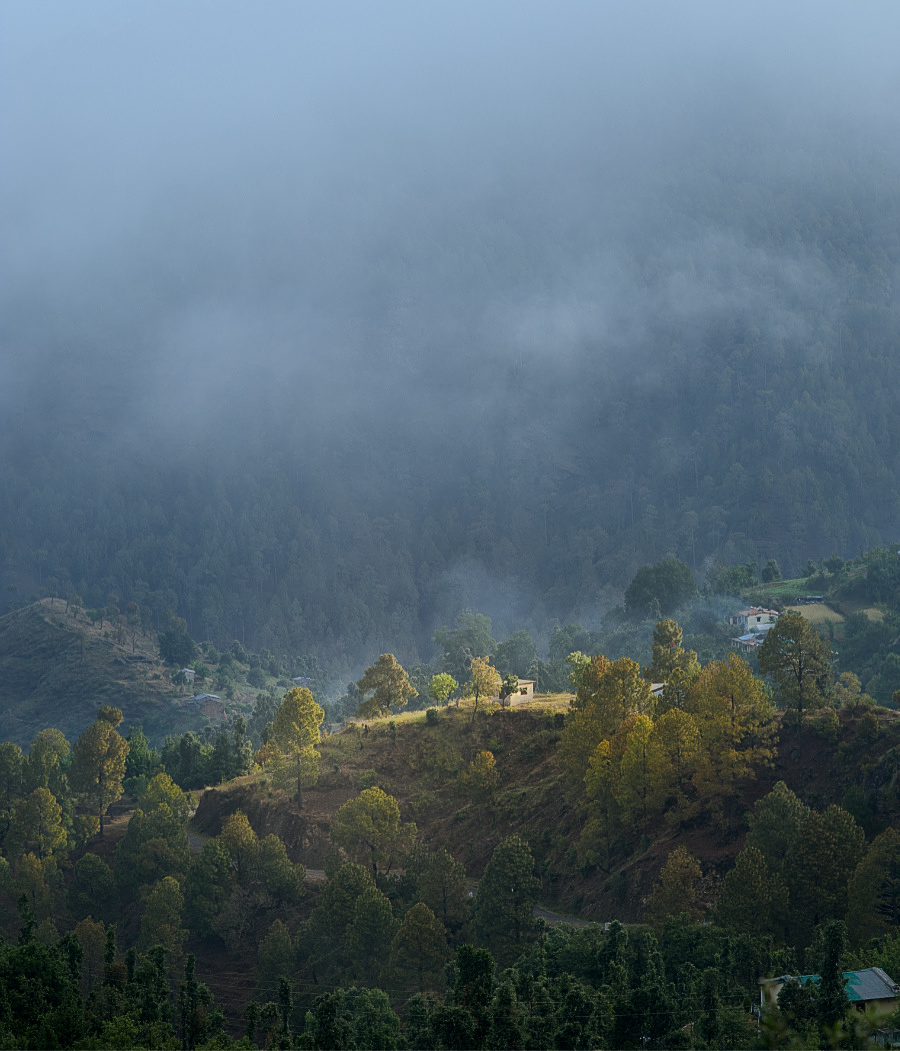The monsoon season brings a captivating charm to the hills. It transforms the surroundings into a lush, vibrant green landscape. The water sources are replenished, and nature comes alive with new energy. The hills become enveloped in floating clouds, occasionally confining us indoors for days. During these moments, we find ourselves captivated, gazing at the mesmerizing display of clouds through the windows, appreciating the beauty they bring to our surroundings.

Like most other things, the rainy season is also a love-hate relationship here in the hills.
The onset of high humidity during the monsoon season takes a toll on stored items in the hills. Prolonged exposure to humidity leads to various signs of moisture damage. Cardboard boxes and paper cartons become soft, while fungus starts to appear if left unattended. Iron tools and even so-called stainless steel develop patches of rust, and clothes acquire a musty smell. These indicators of high humidity can have adverse effects on our health.
Living in the hills has taught me to adapt to these challenges. Firstly, I have eliminated paper boxes and cartons, as they attract moisture and promote fungus growth. Instead, I store my belongings either without these boxes or in plastic trays/containers. I have also learned to keep some of my cupboards slightly open, especially those connected to the floor or walls, to facilitate air circulation and prevent issues. Embracing a minimalist approach to clothing helps too, as fewer items ensure proper airing and exposure to daylight.
While I initially purchased a dehumidifier to dry out my home, I found it to be excessive for my needs. Instead, adapting to the hill environment proved to be a better solution.
Although I appreciate wood paneling and thick woolen carpets for the winter season, they can pose health hazards during the rainy season. Therefore, special care is required to keep them free from mold and fungus.
To mitigate potential issues caused by wood paneling, I limit their use to certain walls only. I have also created a small gap behind the wood panels to allow air circulation and easy treatment in case of fungus growth. In areas where the walls are less prone to dirt, I have shifted my reliance to wall paint.
Similarly, I have replaced thick woolen carpets with thin rugs that can be easily sun-dried whenever the weather clears up, eliminating any odors. Thick carpets are no longer a part of my setup.
Wallpapers are a no-go, as they attract mold even in minimal moisture conditions.
Adopting a minimalist lifestyle has proven beneficial in other aspects as well. I now keep just a small can filled with various nails and screws that come in handy from time to time. My power tools, such as drills and woodworking materials, are stored in open areas rather than inside closed cupboards. I have just a handful of clothes that get to see the daylight every once in a while.
The most crucial step I take is to seize sunny days and utilize them to dry out everything. From shoes to carpets, glassware to books, matchboxes to pillows—anything that can be moved outdoors is basked in the bright sunlight, including myself. This practice not only benefits these items but also contributes to our long-term health.

Building Challenges
Many houses in the hills feature roofs made of steel sheets, stones, shingles, or tin sheets, but they all have a common issue—they tend to leak.
Despite the efforts put into preventing leaks, even the best-built houses can experience leakage. The solution? Acknowledge that the roof is likely to leak and be prepared for it. I always keep a couple of tubes of silicon glue handy to seal any leaks as needed. Waterproofing solutions applied around the house and on the walls can also offer some level of protection.
One of the mistakes that I made during building my place was that I got convinced by my contractor and went in for the smooth wall finish, done using some kind of plaster of partially waterproof base. This was painted on with wall colors. I should have opted for cement-based wall paints without any smoothening of the walls, or maybe for our age-old friend lime. They would have allowed my walls to breathe. In the future, I’ll get someone to scrape off these present bases and colors from the walls and then do them again using either of the other two options.
The soil tends to settle down with rains. That’s true for any place, and the same is true for the hills too. It takes few years at least for the soil to settle down after construction gets completed. I have learnt the hard way that one should wait for this to happen before finalizing any flooring for the outdoors.
Rainwater harvesting is a commendable practice. Although there are ample open areas in the hills where water freely flows and permeates into the ground, I still advocate for storing some rainwater. It proves useful during the dry summer months, and I personally know people who rely entirely on stored rainwater for their needs.

Stuck Indoors
With incessant rains during the monsoons, stepping outside becomes quite a challenge. Within seconds, one can easily end up getting drenched. Umbrellas help but the feet still end up getting wet. While staying indoors and enjoying the rains from the comfort of your windows is the easiest solution, there’s another option that I find even better.
Instead of worrying about getting your feet wet, why not embrace the rain and fully enjoy the experience? Taking a leisurely walk in the drizzle, feeling the tiny droplets float around and gently touch your face, can be truly exhilarating. The smell of fresh moist air, the serenity of fewer people outside, and the ever-changing scenes create an unforgettable ambiance. Sure, you might come back from such a walk with wet feet, but the joy of removing those soggy socks and slipping into a clean, dry pair is nothing short of heavenly.
So, whether you choose to stay indoors, cozy up with a book or some music, and indulge in daydreaming while sipping a hot cup of tea or a nice glass of rum, or you opt for the adventurous path of embracing the rain and taking a delightful stroll, the choice is yours. Just remember, there’s beauty to be found in both scenarios.

Cloud-bursts and Landslides
These sudden bouts of rains have been happening on earth even before humans walked. These are a part and parcel of the rainy season. When damage occurs to houses, roads, when lives are lost, this becomes a concern. However, is it not us who have done deforestation, made the hills bare, used heavy machinery to modify the hills to our fancies, and played havoc with the ecology? It is obvious that damages will occur when clouds burst and land slides down.
I am also scared of such happenings. What if the roads get blocked or some part of the village that I live in slides down? These worries are real but the thing to do is to plant more and more trees.
To contribute to the reduction of deforestation, I have devised a plan to minimize my wood consumption this year. Instead of relying heavily on firewood, I aim to explore alternative methods to keep warm during winters like using hot-water bottles, and layering up with clothes (Keeping Warm in Winters)
Furthermore, I am actively seeking opportunities to utilize reclaimed wood whenever possible. Whether it’s for constructing a decking area, furnishing my living space, or conducting minor repairs, I prioritize using reclaimed wood over newly sourced materials.

Rainy Day and Foodies
While many people associate rainy evenings with indulging in fried snacks, I find myself having a slightly different perspective. Although I do appreciate the taste of these fried delights, the strong smell they generate inside the house tends to overpower me. The enticing aroma of a freshly baked cake or a steaming cup of coffee is perfectly pleasant, but the lingering odor from fried pakoras or French fries becomes too overwhelming for my liking. I prefer to savor these treats in an outdoor setting rather than within the confines of my home. Don’t get me wrong—I do enjoy these snacks; it’s just the enduring scent that tends to bother me long after I’ve finished eating.
During my occasional strolls with an umbrella, I am delighted to discover that the enticing aromas of delicious food occasionally waft through the air, emanating from the few houses scattered along the roadside. Being outdoors allows me to fully appreciate these alluring scents, and on some fortunate occasions, a kind neighbor may even extend an invitation for me to sample their culinary delights. In such instances, I find it thoughtful to bring along a bottle of rum or wine as a token of my gratitude. It wouldn’t be fair to visit someone’s home frequently without bearing a small gift to express my appreciation.

How about some Photography during Rainy Season?
Absolutely! Photography on rainy days is a resounding yes for me. I am captivated by the unique opportunities that arise during this time, from the soft, diffused light to the intriguing subjects and captivating landscapes. The tranquility that accompanies rainy days allows me to carefully compose my images, capturing the beauty that unfolds before me. Without a doubt, the rainy season presents a prime opportunity for me to pursue my passion for photography. If you happen to visit our homestay during rainy season, do try out capturing the beauty of the region.

